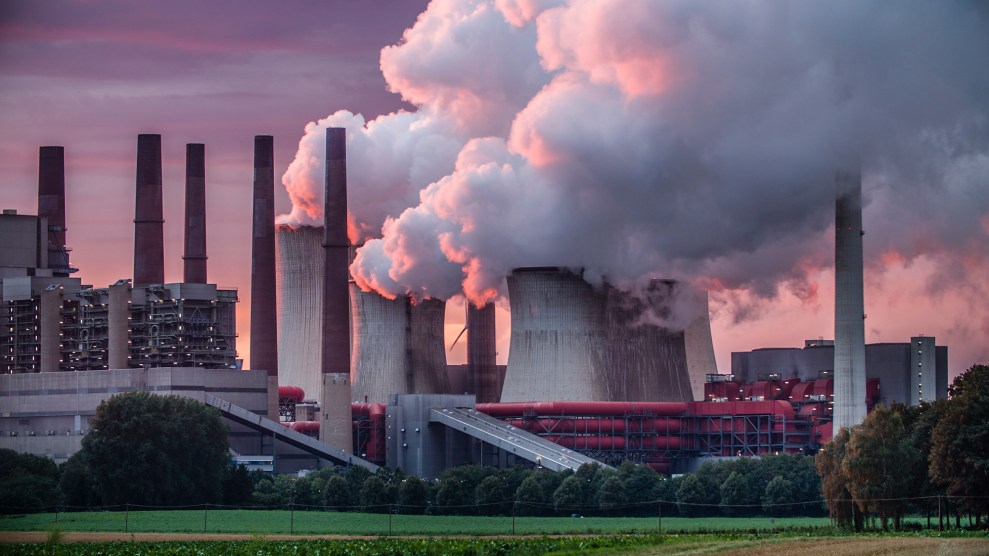
Gary Hershorn/Getty
This story was originally published by Grist and is reproduced here as part of the Climate Desk collaboration.
Thousands of employees of the Environmental Protection Agency are lobbying this week for Congress to address staffing issues that they say are limiting their ability to meaningfully carry out the Biden administration’s ambitious climate goals.
Leaders of AFGE Council 238, a union representing roughly half of the EPA’s 14,000-member workforce, said in a memo that non competitive salaries and a lack of career development opportunities are fueling attrition and overburdening staff. Congress could address these issues by expanding the EPA’s funding in the annual appropriations legislation, which it will write later this year. Failure to do so, the union warned, will jeopardize the implementation of President Joe Biden’s two major legislative achievements—the Bipartisan Infrastructure Law of 2021 and the Inflation Reduction Act of 2022.
Union leaders began briefing members of Congress about the situation on Monday, presenting them with a series of demands that include the creation of a more robust promotion structure and the development of a program to support equity and inclusion. Staffers are also planning a rally at EPA headquarters on Wednesday.
Sources familiar with the EPA’s workforce told Grist that the actions on Capitol Hill this week have been a long time coming.
The EPA has spent the past six years embroiled in multiple crises. Hundreds of senior staff members departed after former President Donald Trump rolled back dozens of environmental safeguards, creating gaps in institutional knowledge that continue to haunt the agency today. The COVID-19 pandemic further hobbled enforcement programs, as on-the-ground inspection rates for power plants, refineries, and other pollution sources plunged.
Now, the threat of climate change is expanding the EPA’s mission in a way that Congress could not have imagined when the agency was founded in the early 1970s. The Bipartisan Infrastructure Law and Inflation Reduction Act will require staff members to dole out billions of dollars in grants to state and local initiatives and expand its Superfund cleanup program to protect communities of color living near sites of uncontrolled contamination. The agency will take on these efforts at the same time as it fulfills its regular statutory duties, which include developing complicated new rules to reduce greenhouse gas emissions from power plants and vehicles and increasing enforcement efforts to ensure companies are abiding by those regulations. But staffing levels have not kept up with these expanded duties.
Today, the workforce is around the size that it was under President Ronald Reagan in the 1980s. The AFGE has said that the agency will need 20,000 full-time staff, a 40 percent increase, to carry out the programs it has been tasked with.
Nicole Cantello, who practiced as an EPA attorney for three decades before joining AFGE Council 238 full time in 2020, told Grist that the issue is not only with hiring, but also with retention. A dearth of promotional opportunities and limited work-from-home options have caused retirement-age employees to depart early. Roughly 20 percent of the EPA’s staff have been at the agency for 30 years or more and could elect to retire soon.
“We want to push EPA to create a retention plan that will keep that cohort at the agency for a little longer, because we have a five to 10-year window here to implement” the Inflation Reduction Act and the Bipartisan Infrastructure Law, she said.
Tim Whitehouse, the executive director of the Public Employees for Environmental Responsibility, a nonprofit that is campaigning with AFGE in Washington this week, said that in addition to helping the U.S. achieve its climate goals, an expanded workforce would allow the EPA to more thoroughly develop its own science instead of relying on studies designed and developed by industrial companies. He pointed to the EPA program that issues rules around the use of toxic chemicals like per- and polyfluoroalkyl substances, or PFAS, also known as “forever chemicals.” In the past, industrial companies have tried to conceal the hazards of these types of chemicals, leading to lags in their regulation.
“That’s an actual example of how understaffed parts of EPA can make mistakes that have long-term human health consequences,” he said.
EPA spokesperson Melissa Sullivan told Grist that the agency is working to onboard nearly 1,800 new employees and that attrition rates at EPA are among the lowest in the federal government. She added that the agency has significantly expanded its outreach program to target qualified candidates.
“While the federal government often cannot equal private sector salaries, it can provide employees with more stability and other benefits,” she said. “Specifically, the agency offers the opportunity to protect human health and the environment and positively affect an untold number of people’s lives.”
For members of AFGE, the staffing shortages are both personal and existential. A failure to address them could have repercussions for generations to come.
“Our mission has grown enormously, and climate challenges continue to escalate, but EPA’s inability to hire and retain staff has created a crisis,” said AFGE Council 238 President Marie Powell Owens in a statement. “We need to raise pay and restore career ladders now. The future of the EPA and our planet are at stake.”
















